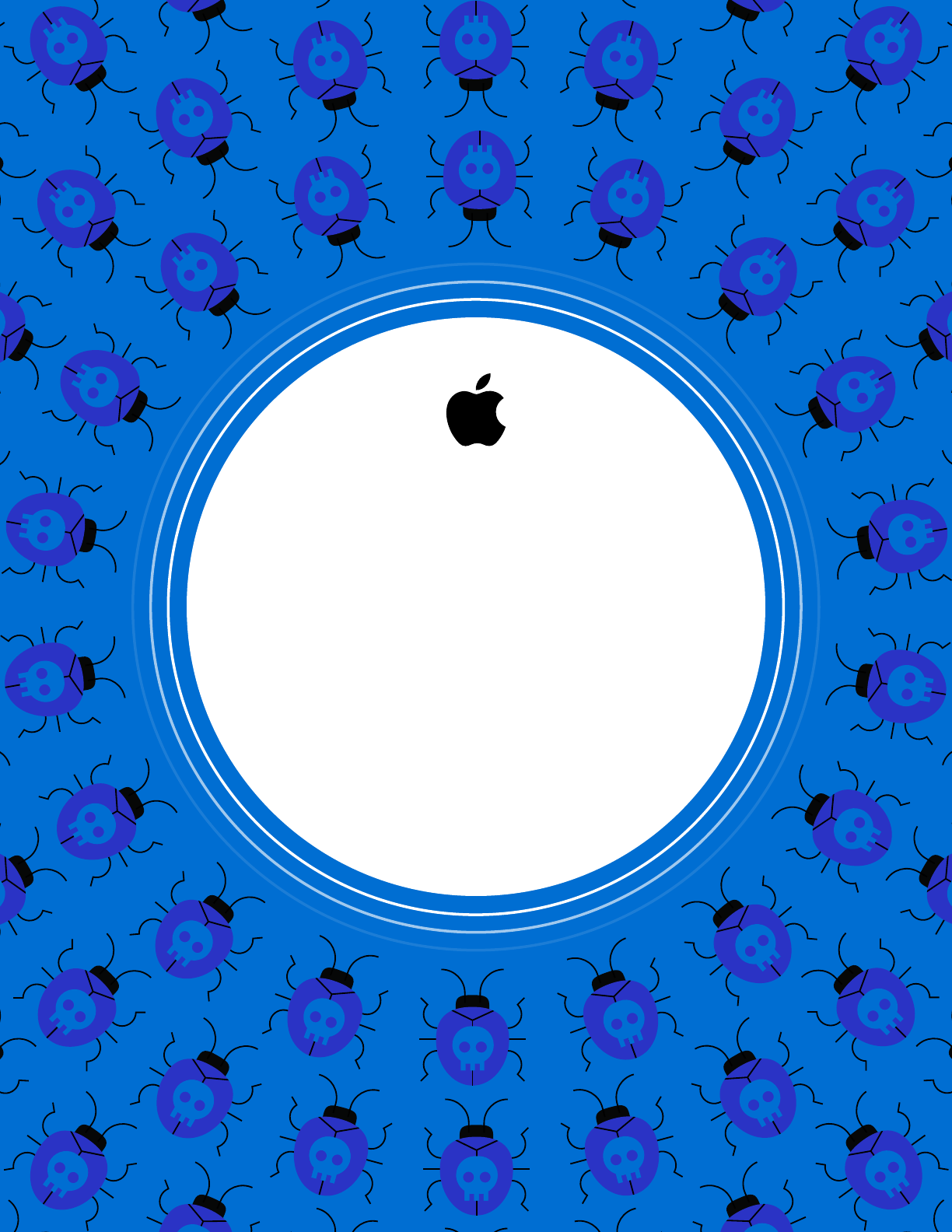
Building a Trusted
Ecosystem for
Millions of Apps
A threat analysis of sideloading
October 2021

2
Key Insights
iPhone is a highly personal device where users store some of their most sensitive
and personal information. This means that maintaining security and privacy on the
iOS ecosystem is of critical importance to users. However, some are demanding
that Apple support the distribution of apps outside of the App Store, through direct
downloads or third-party app stores, a process also referred to as “sideloading.”
Supporting sideloading through direct downloads and third-party app stores
would cripple the privacy and security protections that have made iPhone so
secure, and expose users to serious security risks.
Mobile malware harms consumers, companies, developers, and advertisers.
Attacks on users employ various tactics and techniques. Common types of mobile
malware affecting consumers are adware, ransomware, spyware, and banking and
other credential-stealing trojans that masquerade as legitimate apps. Cybercriminals
often reach their targets through social engineering or supply chain attacks, and
sometimes use popular social media networks to spread the scams and attacks.
Most rely on third-party app stores or direct downloads to spread malicious apps.
Developers and advertisers are also harmed by these attacks, mostly through piracy,
intellectual property theft, and loss of advertising revenue.
Mobile malware and the resulting security and privacy threats are
increasingly common and predominantly present on platforms
that allow sideloading.
Over the past four years, Android
devices were found to have
15 to 47 times more malware
infections than iPhone.
Nearly 6 million attacks per
month were detected by a large
security firm on its clients’
Android mobile devices.
A European regulatory agency
reported 230,000 new malware
infections per day.
15–
47x
more infections
3
If Apple were forced to support sideloading:
• More harmful apps would reach users because it would be easier for
cybercriminals to target them – even if sideloading were limited to
third-party app stores only. The large amount of malware and resulting
security and privacy threats on third-party app stores shows that they do
not have sufficient vetting procedures to check for apps containing known
malware, apps violating user privacy, copycat apps, apps with illegal or
objectionable content, and unsafe apps targeted at children. Users would
now be responsible for determining whether sideloaded apps are safe, a
very difficult task even for experts. In the rare cases in which a fraudulent
or malicious app makes it onto the App Store, Apple can remove it once
discovered and block any of its future variants, thereby stopping its spread
to other users. If sideloading from third-party app stores were supported,
malicious apps would simply migrate to third-party stores and continue to
infect consumer devices.
• Users would have less information about apps up front, and less control
over apps after they download them onto their devices. Users may not get
accurate information about apps they sideload through third-party app stores
or via direct downloads because these app stores would not be required to
provide the information displayed on the App Store product pages and privacy
labels. And features like App Tracking Transparency and parental controls
that allow users to control what iPhone data, hardware, and services can be
accessed by those apps (such as the device’s location, microphone, and
camera) either would not be available or would be much easier for malicious
actors to manipulate. Large companies that rely on digital advertising allege
that they have lost revenue due to these privacy features, and may therefore
have an incentive to distribute their apps via sideloading specifically to bypass
these protections. Privacy on the iOS platform would therefore be eroded.
• Some sideloading initiatives would also mandate removing protections
against third-party access to proprietary hardware elements and
non-public operating system functions. This would undermine core
components of platform security that protect the operating system and iPhone
data and services from malware, intrusion, and even operational flaws that
could affect the reliability of the device and stop it from working. This would
make it easier for cybercriminals to spy on users’ devices and steal their data.
4
Even users who don’t want to sideload and prefer to download
apps only from the App Store would be harmed if sideloading
were supported.
• Users could be forced to sideload an app they need for work or school.
Users also may have no choice other than sideloading an app that they need to
connect with family and friends because the app is not made available on the
App Store. For example, if sideloading were permitted, some companies may
choose to distribute their apps solely outside of the App Store.
• Cybercriminals may trick users into sideloading apps by mimicking the
appearance of the App Store, or by touting free or expanded access to
services or exclusive features.
By reviewing every app before it becomes available on the App Store to ensure it is
free of malware and accurately represented to users, and by swiftly removing apps
from the App Store if they are found to be harmful and limiting the spread of future
variants, Apple protects the security of the ecosystem. Sideloading, through
either direct downloads or third-party app stores, would undermine Apple’s
security and privacy protections, and is not in the best interest of users’
security and privacy.
“ We’re trying to do two diametrically opposed things
at once: provide an advanced and open platform to
developers while at the same time protect iPhone
users from viruses, malware, privacy attacks, etc.
This is no easy task.”
Steve Jobs, October 17, 2007
Contents
The current mobile threat landscape 7
Snapshot of common consumer mobile malware 10
How mobile malware attacks access users’ devices 17
The risks of opening the ecosystem 19
The limited mechanism to distribute apps outside
of the App Store 20
The impact of sideloading on the iOS ecosystem 22
Sideloading and iOS users 27
Guidance from security experts 28
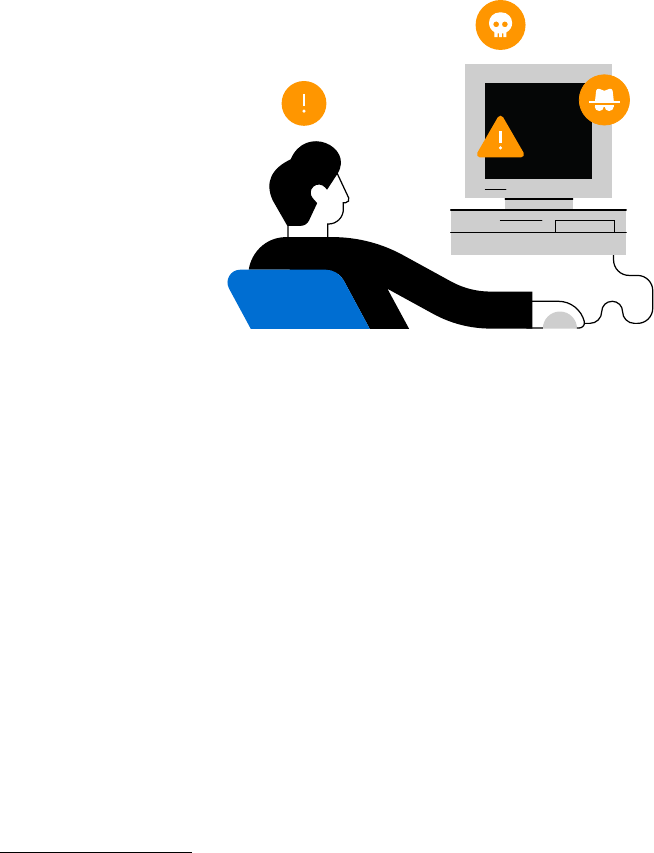
6
When iPhone was developed, PCs were the world’s primary computing
tools, and they were riddled with viruses. PC users often encountered serious
reliability issues because downloading software or visiting a website could result
in their machines becoming infected with malware. Apple designed iPhone with
the knowledge and intention that it would be a highly personal device where users
would store some of their most sensitive and personal information, and could be
used by a much larger and more diverse user base than was the case with PCs.
They would keep it with them wherever they went and rely on it during emergencies.
iPhone could not fall victim to the fate of PCs – it needed to be different.
To provide reliability and security for users while establishing a platform for
third-party developers to create and distribute apps, Apple built industry-
leading security protections into iPhone and created the App Store, a trusted
place where users could safely download vetted third-party apps. This
approach has been effective: It is extremely rare for a user to encounter malware on
iPhone. However, some are demanding that Apple support the distribution of apps
outside of the App Store, through direct downloads or third-party app stores, a
process also referred to as “sideloading.” Supporting sideloading would cripple the
privacy and security protections of the iOS platform and expose users to serious
security risks.
Sideloading on iPhone would open opportunities for cybercriminals. Malicious
actors would be galvanized to develop tools and expertise to attack iPhone users
because of the additional opportunities and distribution channels sideloading would
provide. The increased risk of malware attacks would put all users at greater risk,
even those who prefer to download apps only on the App Store. Plainly, sideloading
is not in the best interest of users. Developers would be harmed as well, because
the increased threat from sideloading would erode users’ trust in the ecosystem,
resulting in many users downloading fewer apps from fewer developers, and making
fewer in-app purchases. Developers would also be harmed by the proliferation
of fake and copycat apps, as well as pirated apps.
You can read Apple’s June
2021 paper, "Building a
Trusted Ecosystem for
Millions of Apps: The
important role of App
Store protections," to see
how a family’s everyday
experience using their
iPhone would be different
with sideloading.
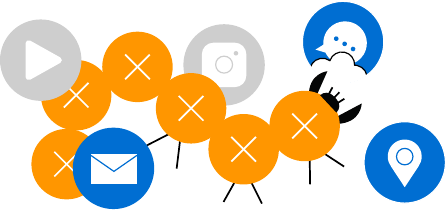
7
The current mobile threat landscape
Mobile security threats are increasingly common, especially on platforms
that support sideloading. The European Union’s cybersecurity agency, ENISA,
reported the detection of 230,000 new malware infections per day – i.e., 84 million
per year – in 2019 and early 2020.
1
Kaspersky Lab, Europe’s largest cybersecurity
services provider, estimated that in 2020, nearly 6 million attacks per month
affected Android mobile devices owned by its clients.
2,3
These threats are predominantly present on platforms that support
sideloading: Recent studies have shown that devices that run on Android – a
platform that supports sideloading – have an estimated 15 to 47 times more
infections from malicious software than iPhone.
4,5
Mobile apps containing security threats pose significant risks.
4,6
As a result,
app review processes in first-party app stores (i.e., the App Store on iOS devices,
and Google Play on Android devices) have become increasingly thorough and
necessary to prevent security threats from reaching consumers. However, such
app review protections are not always thorough, or even available at all, when users
sideload apps from third-party app stores or direct downloads.
Malware-infected mobile apps put all stakeholders in the mobile ecosystem
at risk. While consumers are often the primary targets, malware attacks can harm
and expose developers, online advertisers, and even businesses that are not direct
participants in the mobile app ecosystem. Consumers who are victims of malware
attacks are defrauded by cybercriminals, have their privacy and sensitive data
compromised, and waste time and energy dealing with the consequences of the
attacks.
7
Malware-infected mobile apps are also often the first step in complex
multi-step campaigns that allow cybercriminals to carry out a variety of attacks
targeting a victim’s financial resources.
8,9,10
On platforms that support sideloading,
many consumers have also needed to add antivirus services on their devices to
attempt to stem the problem – at a cost of $3.4 billion per year for those services.
In 2021, an estimated 1.3 billion smartphones worldwide were equipped with
security solutions – four times as many as in 2016.
11
Cybercriminals, however,
are always a step ahead, meaning antivirus services are an incomplete patchwork
solution to the growing malware problem.
12
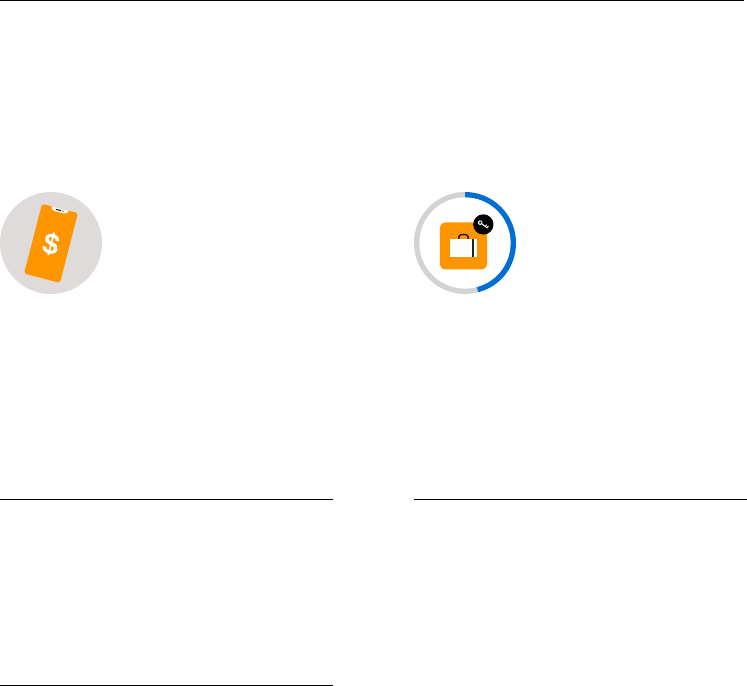
8
Malware designed to infect an individual’s mobile device can also affect
corporate data and corporate networks. There are many ways that hackers
attack companies, for example by using phishing or attacking unpatched systems,
and mobile malware has become an additional avenue to do so.
13,14,15
With many
organizations around the world adopting Bring Your Own Device (BYOD) policies
that encourage employees to use their personal devices on corporate networks,
mobile malware attacks can provide bad actors a direct route into corporate
networks, which has led to an increase in threats targeting mobile devices.
16,17,18
Many IT and security experts have attributed certain data breaches to employees
failing to secure sensitive corporate information on their mobile devices, and a study
of corporate data breaches identified Android apps as one delivery method for
malware.
10,19
Once bad actors manage to gain access to a corporate network, firms
then face all types of attacks and security risks, such as ransomware, data theft, or
loss of control of their network, all of which can lead to the loss of customer trust
and litigation.
20
CORPORATE COSTS OF MALWARE ATTACKS
Firms face high costs from malware attacks, which can originate
via mobile apps, among other sources:
One single mobile device
infected with malware costs
an organization an average
of nearly $10,000.
19
Among 1,800 US firms, 46
percent had at least one
employee download a malicious
mobile app that threatened the
company’s network and data.
21
DATA BREACHES
Data breaches, which can originate from
mobile app malware, cost firms an average
of over $4 million per breach, with
estimates reaching up to $50 million.
19, 22
LOST BUSINESS
Out of that $4 million, over $1.5 million is due
to lost business. This cost includes the harm
to reputation, which makes it more difficult
for these firms to acquire new customers.
22
RANSOMWARE
More than half of companies surveyed
in France, Spain, Germany, and other
European countries suffered a ransomware
attack in 2019. Ransomware attacks,
which can originate from mobile malware,
cost companies more than $750,000 to
remediate on average.
23
9
Developers and advertisers are also harmed by cybercriminals. When pirating
an app, cybercriminals illegally distribute another developer’s app, primarily through
third-party sources (including third-party app stores), causing the developer
to lose out on the app’s revenue.
24,25
Cybercriminals may remove or replace
the monetization tools that allow the developer to earn revenue, such as in-app
purchases or advertising. In other cases, bad actors copy the design, branding,
or content from another developer, profiting off of stolen intellectual property.
26,27
This means that app piracy and intellectual property theft cause developers to
lose out on revenue. Several game developers, for example, have reported that 90
percent of their app installations on Android devices are pirated versions for which
they earn no revenue.
24,25
Cybercriminals often target paid games, profiting by
creating pirated versions of successful games such as Monument Valley, the Grand
Theft Auto series, or Alto’s Adventure.
24,25
Advertisers are also harmed by mobile malware when cybercriminals and hackers
use techniques such as click fraud and ad stacking, which frequently operate
through sideloaded apps.
28
Click fraud malware automatically directs traffic to web
pages containing ads or clicks on ads to generate revenue on a per-view or per-
click basis, respectively.
29
With ad stacking, malware layers multiple advertisements
over one another so that, while the user only sees the top one, the advertiser is
fraudulently billed for all the ads.
30
Damages to legitimate advertisers from inflated,
fraudulent ad traffic are estimated to amount to billions of dollars.
30,31
Threats to mobile users have only compounded due to the increased reliance
on mobile devices driven by the coronavirus pandemic. For example, consumers
are now more likely to store personal health information on their devices, a type of
valuable data that hackers can sell to multiple buyers.
32,33
Firms increasingly rely
on BYOD policies to support remote work.
17
These dynamics have created more
opportunities for bad actors and increased the number of threats to mobile users.
For example, mobile phishing – using fake messages to trick users into revealing
confidential information or downloading malware – has increased by 37 percent.
34
Hackers have embedded malicious malware in COVID-19 apps and resources.
35
And healthcare-related networks have experienced 15 percent more coronavirus-
related malware attacks per user across mobile devices, tablets, and PCs than the
average network.
34
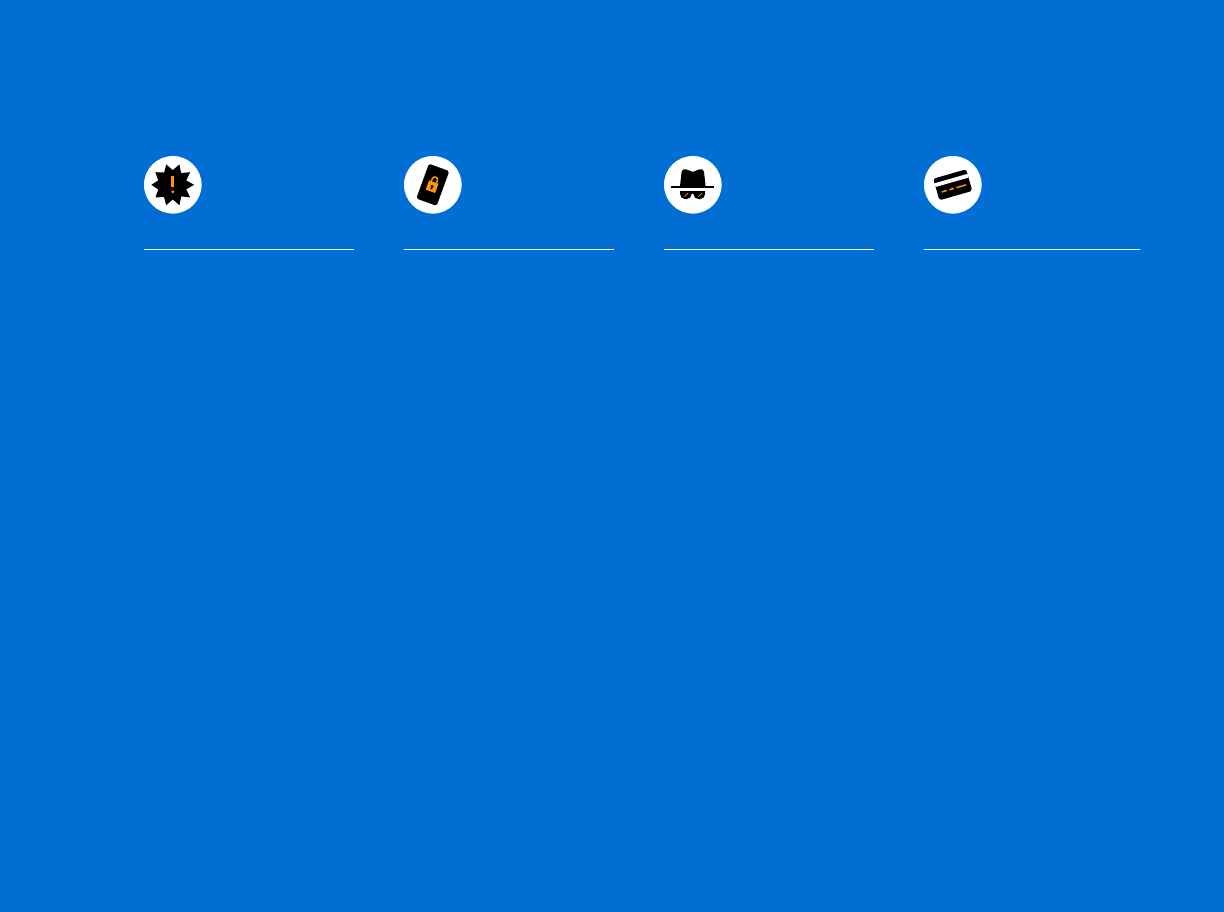
10
Snapshot of common consumer mobile malware
Mobile malware attacks against consumers take many forms and use
various tactics and techniques to attack them. The most common types
of consumer mobile malware are adware, ransomware, spyware, and banking
and other credential-stealing trojans masquerading as legitimate apps. (See
Snapshot below.) Once attackers gain access to a device, they often use
multiple tactics to exploit their targets: For instance, they can infect the device
with both adware and spyware.
Note: This table reflects classifications proposed by cybersecurity firms such as Kaspersky Lab, Malware-
bytes, WeLiveSecurity by ESET, Norton, and Nokia, and government agencies such as the European Union
Agency for Cybersecurity (ENISA).
Generate ad revenue
by serving the user
aggressive (or
fraudulent) ads
GOAL
Adware
Nuisance in the form of
excessive pop-up ads
Harms performance
of device
IMPACT
ON USER
Snapshot of common consumer mobile malware
Extract money from
infected user, promising
to "release" a hijacked
device in exchange
Ransomware
Loss of access to device
and critical files
Data loss
Financial harm if user
pays ransom
Use data to target users
Sell data to hackers
Conduct intimate partner
surveillance (IPS)
Consumer
spyware
Violate users’ privacy
IPS: Enables abuse,
potential physical and
mental harm
Access a device to steal
banking information
or other user login
credentials
Banking and
credential-
stealing trojans
Stolen credentials (e.g.,
banking login, social
media account login)
Harm from stolen
credentials (e.g., fraud)

11
HOW IT WORKS
HiddenAds displays various
pop-up ads and website redirec-
tions in the device’s browser to
generate advertising revenue for
the malicious actor.
HOW IT HIDES
Once installed, the app appears as
a fake settings icon. The icon can
even disappear with the adware
still running in the background.
Other examples
of adware
FakeAdsBlock, a sideloaded
Android trojan posing as
a legitimate ad blocker,
pollutes the device with
pop-ups and redirections.
It is very difficult to remove.
40
Android.Click.312.origin
clicker trojan is embedded
in many legitimate apps.
It generates ads on the
apps and can load websites
without user knowledge.
41
CopyCat infects Android
devices with adware and
rooting malware. It spreads
through tampered copies
of popular apps released
on third-party app stores.
42
In two months in 2016,
CopyCat malware infected
more than 14 million Android
devices around the world.
43
WHO IT AFFECTS
Since its discovery in 2020, there
have been over 30,000 recorded
HiddenAds attacks, affecting
users worldwide.
HOW IT REACHES A USER’S DEVICE
Apps infected with HiddenAds
adware masquerade as genuine
Android apps, such as fake
versions of FaceApp – a popular
photo modification app – and a
Call of Duty game.
37
YouTube
videos advertise these fake apps
as free versions of legitimate
apps and include download links.
HiddenAds: Adware that hides
inside free apps and games to
display intrusive ads
Settings
Adware. Present in over half of mobile attacks, adware serves users invasive
advertisements to generate advertising revenue.
36,37,38
Adware can infiltrate
mobile devices through apps, manifesting as pop-ups, redirections, clicker
trojans, and unwanted installations.
39
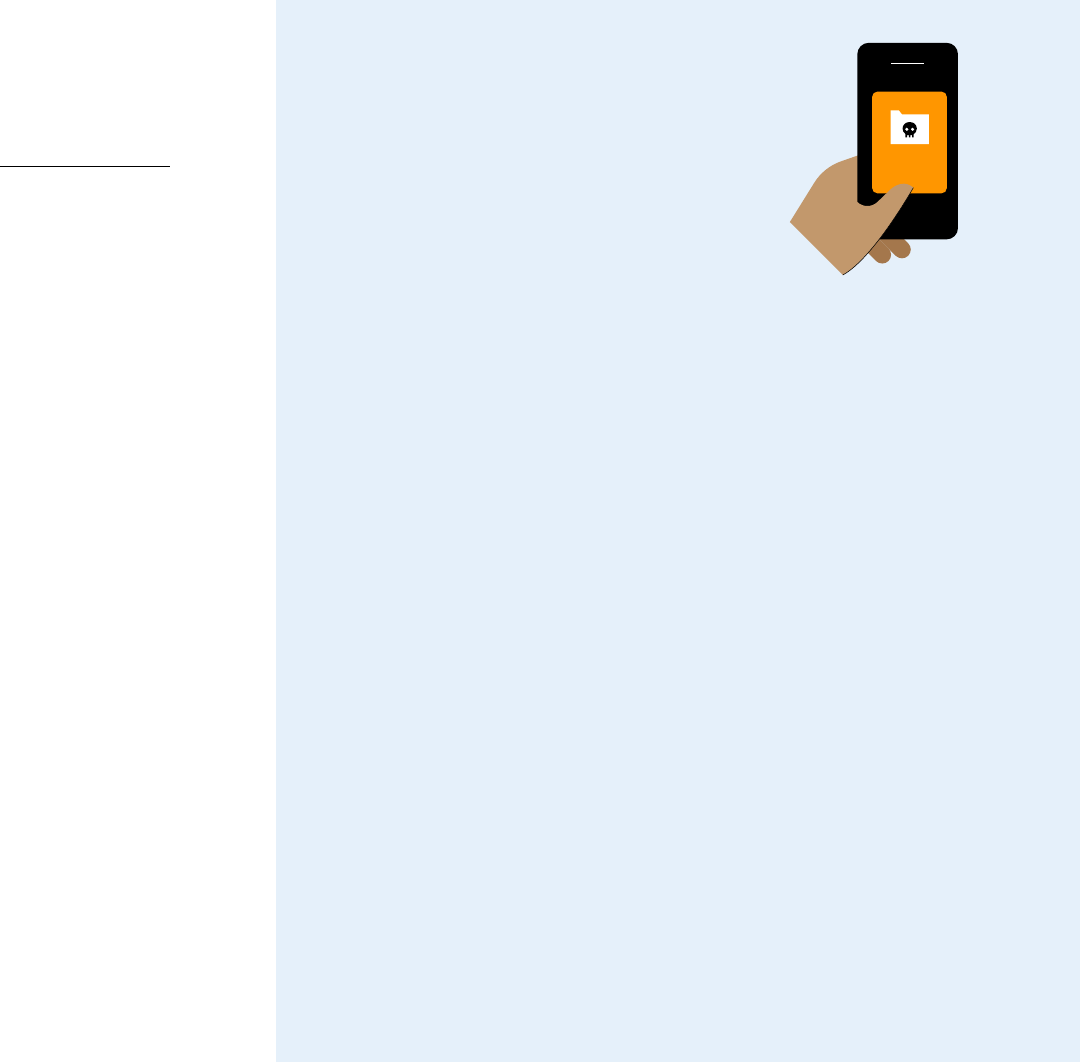
12
Other examples
of ransomware
Fusob ransomware trojans
are designed to lock a
device while stealing call
history, location history, and
other sensitive data. These
trojans have targeted users
in Europe and the US.
53,54
MalLocker.B, a family of
Android malware distributed
via sideloading, displays
a ransom note over every
other app window, ensuring
that the target cannot use
any other features of the
phone.
55,56
CryCryptor ransomware poses
as an official COVID-19 tracing
app from government agency
Health Canada to trick users into
sideloading it. Once installed,
CryCryptor encrypts files on the
device and provides an email
address to contact to proceed
with ransom payment and file
recovery.
51,52
WHO IT AFFECTS
CryCryptor targets Android users
in Canada.
HOW IT REACHES A USER’S DEVICE
In June 2020, mere days after
the Canadian government
announced plans to roll out a
COVID-19 contact-tracing app, the
cybercriminals behind CryCryptor
Ransomware. Another common type of mobile security attack, ransomware,
generally targets individual users by blocking a device’s interface, preventing users
from using it until a ransom is paid, or by encrypting files in the device and only
decrypting them after a payment is made.
44,45
Cybercriminals using ransomware
often steal sensitive data and threaten to spread it.
46
In 2020, more than 4.2 million
mobile users in the US alone were victims of mobile ransomware attacks.
47,48
These
attacks have become more common, fueled by the coronavirus pandemic and the
rise of cryptocurrency, which cybercriminals can trade to avoid being traced.
34,47,49,50
created two fake Health Canada
websites through which they offered
their ransomware app. Preying on
people’s anxiety and uncertainty
surrounding the COVID-19 pandemic,
they tricked Android users into
sideloading CryCryptor from these
fake websites.
HOW IT WORKS
CryCryptor was developed from
CryDroid, an open-source ransoware.
Once downloaded, CryCryptor
requests permission to access files
on the Android device. Then, the
malware encrypts common file types,
including photos, videos, and PDFs.
A ransom note is attached to each
encrypted file directory, containing
an email address to contact regarding
payment and file recovery.
CryCryptor: Ransomware
poses as an official
COVID-19 tracing app
and encrypts users’ files
Your files are
compromised

13
Consumer spyware. Spyware monitors the device’s user and steals
sensitive information, such as messages, photos, and videos.
57
Spyware
can harm both individuals (e.g., via identity theft or stalking) and businesses
and organizations (e.g., via corporate espionage).
58
Certain invasive forms of
spyware can directly access a device’s microphone or camera.
59,60
Consumer
spyware is distinct from the highly sophisticated and narrowly targeted
forms of spyware executed by nation-states via intelligence agencies. Unlike
spyware developed or sponsored by nation-states, consumer spyware is
designed to target a broad set of users, and is relatively cheap to produce
and distribute on platforms that support sideloading. In 2020, a third of all
Android malware attacks involved spyware.
4
Spyware has also been used by abusers to surveil intimate partners and
their mobile devices. Apps containing such software, known as stalkerware,
are used to track location, messages, emails, and photos, and to access
the device’s camera in real time. The use of such apps is associated with
harassment, stalking, and domestic violence. In the last few years, the
FTC has taken action against two US companies that sold stalkerware that
allowed stalkers and domestic abusers to track their victims on Android
devices.
61,62
In both cases, even though the apps were not distributed on
Google Play, abusers were able to sideload the apps onto victims’ devices.
The FTC’s intervention was therefore critical in removing the apps from
distribution.
61,63
One survey found that more
than half of abusers tracked
their victims’ mobile phones
using stalkerware apps.
64
Kaspersky Lab discovered
over 50,000 users who were
affected by stalkerware in
2020.
65
The vast majority of
stalkerware is distributed
outside of first-party app
stores.
65
Examples
of spyware
FluBot is a strain of spyware
that behaves and spreads
very similarly to FakeSpy. (See
below.) FluBot poses as a DHL
package tracking app across
Europe, and focuses its attacks
in the UK and Finland.
68,69
SpyNote spreads as a
sideloaded, fake version of
Netflix that can take control
of a device’s microphone,
contacts, and messages.
70
HelloSpy, a type of stalkerware
available only through side-
loading, records the target’s
GPS location, phone calls,
messages, photos and videos,
and other data.
71
It is marketed
to “catch cheating spouses.”
72

14
WHO IT AFFECTS
Android users in France,
Switzerland, Germany, the
UK, the US, Japan, and
Taiwan, among others.
HOW IT REACHES
A USER‘S DEVICE
A target receives a text
message claiming that the
postal service attempted
to deliver a package, and
that the user should track
or sign for it. The message
contains a link to a website
that prompts users to
sideload the fake delivery
tracking app. FakeSpy
has masqueraded as mail
services in France (La
Poste), Switzerland (Swiss
Post), Germany (Deutsche
Post DHL), the UK (Royal
Mail), the US (USPS),
Japan (Japan Post), and
⤷ Fake messages attempt to trick users into
sideloading FakeSpy via fraudulent postal
service apps.
⤷ FakeSpy app icons mimic those of
legitimate postal services around
the world.
FakeSpy is actively evolving
to include new evasion
strategies and spying
capabilities. FakeSpy
proliferates by sending
SMS phishing messages to
the infected user’s contact
list.
66
It is also expanding to
mimic more legitimate postal
services around the world to
target new groups of users.
Taiwan (Chunghwa Post).
To trick potential victims,
the sideloaded app’s icon
resembles the official app
icon for one of these official
mail services.
HOW IT WORKS
Once the user has sideloaded
the app, it requests
permissions that allow it
to obtain text messages,
contact lists, call logs,
network information, recently
run tasks, and information
about other apps.
HOW IT HIDES
After the user launches the
app, it deceptively redirects
them to the real postal
service website, which helps
the app remain undetected
as malware.
FakeSpy uses SMS
phishing to trick people
into sideloading an Android
app that masquerades as
a legitimate postal service
app. Once downloaded, it
steals sensitive information
from the device.
66,67
FakeSpy: Malware poses as fake
package delivery messages to spy
on users and steal their data
Today
Now
Royal Mail USPS Mobile JP Post Swiss Post
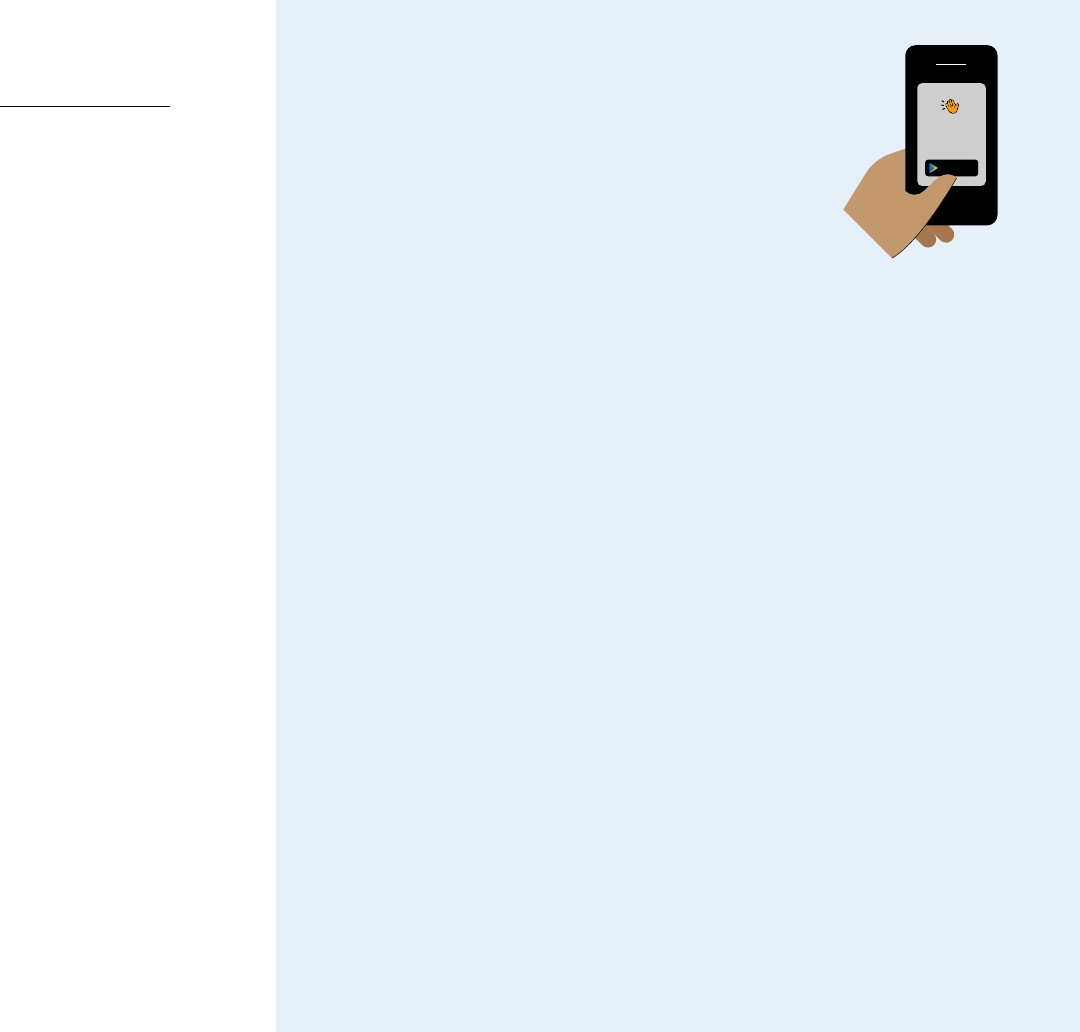
15
Other examples
of banking and
credential-stealing
trojan apps
Banker.BR, an Android trojan,
uses screen overlays to steal
banking information in Spain
and Portugal.
77
TeaBot, a banking trojan,
impersonates many popular
apps in Western Europe to
steal banking information
and gain remote access to
devices.
78,79
Since 2017, Anubis banking
trojans have posed as the
apps of over 300 financial
institutions and other types
of apps.
80
Once installed and
activated, the apps request
unnecessary permissions
that allow them to execute
nefarious commands. The
malware predominantly uses
phishing to trick people into
providing their bank account
information.
BlackRock is an Android trojan
that steals login credentials from
over 450 online services, and tricks
users into sideloading it by posing
as the Clubhouse app.
75,76
WHO IT AFFECTS
Android users in Europe and other
parts of the world.
HOW IT REACHES A USER’S DEVICE
BlackRock spreads via a spoofed
version of the Clubhouse website.
When a user clicks “Get it on
Google Play,” the trojan is automat-
ically downloaded.
HOW IT WORKS
The trojan poses as a Google update,
and asks for Accessibility Service
privileges. With those privileges, it
can grant itself further privileges
to function without requiring user
input.
76
The next time the user opens
one of the targeted apps, such as
BBVA, Lloyds Bank, or Facebook,
the trojan launches a screen overlay
window over the app’s interface that
records the user’s login credentials
as they are typed. The trojan can
access text messages, which allows
it to defeat two-factor authentication.
HOW IT HIDES
When the trojan is first launched
on the device, it hides its app icon,
thereby making itself invisible to
the user.
BlackRock: An Android trojan
poses as a fake version of
Clubhouse to steal login
credentials
Banking and other credential-stealing trojans. Common types of
mobile malware are banking and other credential-stealing trojans.
Disguised as legitimate apps, they aim to steal users’ credentials from
banks, government accounts, or social media accounts, for example.
Some banking trojans are capable of bypassing two-factor authentication
security measures.
73
The goal of banking trojans is to ultimately steal the
credentials and money from the target’s bank account.
74
Banking trojans
are most commonly sideloaded.
74
See if you
have friends
on Clubhouse
GET IT ON
Google Play

16
Other forms of malware. Other well-known forms of malware, while
similar to consumer malware, are typically not delivered through mobile
apps and not targeted at everyday consumers.
• Nation-state spyware is developed and sponsored by state actors
via intelligence agencies or private contractors, often with the goal of
advancing a nation’s intelligence or national security objectives. Unlike
consumer spyware, nation-state spyware is highly sophisticated, costs
millions of dollars to develop, is typically not delivered via apps, and is
used to target specific individuals.
81,82,83
• Enterprise ransomware occurs when criminals take control over
corporate networks and demand ransom from the affected company
in exchange for restoring access or preventing the cybercriminals
from publicly releasing sensitive data stolen from the victim’s
network.
84
Enterprise ransomware differs from mobile ransomware
attacks (in which a consumer’s device and personal data are held
ransom), although employees’ mobile devices can be an entry point
for cybercriminals targeting corporations.

17
How mobile malware attacks access users’ devices
Cybercriminals and hackers can distribute malware to users through third-
party app stores and via direct downloads from websites or even as email
attachments.
8
As described below, a huge majority of malware – over 99 percent
– comes from sideloaded apps, because first-party stores like the App Store have
protections in place that prevent these distribution techniques from targeting
users. The most common way for malware attackers to reach their targets is
through social engineering or spoofing, i.e., using deception and manipulation as
techniques to obtain users’ trust and get access to their devices. One study found
that 98 percent of all cyberattacks rely on social engineering.
18
Hackers sometimes
use social media networks to spread scams and attacks, exploiting people’s trust in
their friends and family.
85,86
There are many ways in which spoofing attacks, which
are more likely to happen through sideloaded apps, try to obtain users’ trust:
Copycat apps (or fake apps) copy the name, interface, and functionalities of other
apps to acquire some of their users.
87,88
They capitalize on users’ trust in popular
(and legitimate) apps, such as Netflix, Candy Crush Saga, and Clubhouse, possibly
hurting the image and reputation of those legitimate developers.
70,89
Commonly
downloaded via sideloading, these apps have fooled tens of millions of users
worldwide.
43,90,91
Fake system updates are a common spoofing technique in which malware
pretends to be a system update, tricking users into downloading it and providing
access to their devices. For example, a sideloaded Android app posed as a system
update to infect users’ devices.
92
Email and phishing messages are another technique that malware attacks
employ to convince users to download malware, appearing to be from senders the
users trust.
8,93
These phishing messages commonly spread through social media
apps. For example, FlyTrap, a malicious trojan on third-party app stores, spreads
by hijacking users’ Facebook accounts to send personalized messages to victims’
social connections with links to the trojan.
85
In Spain, people received mobile
messages advertising and containing a link to sideload a fake and malware-ridden
“Coronavirus Finder” app.
94
In India, users received personalized SMS messages
urging them to download a copycat of the tax-filing app from the official Income
Tax Department of India. The app contained malware designed to steal their
personal and financial information.
95
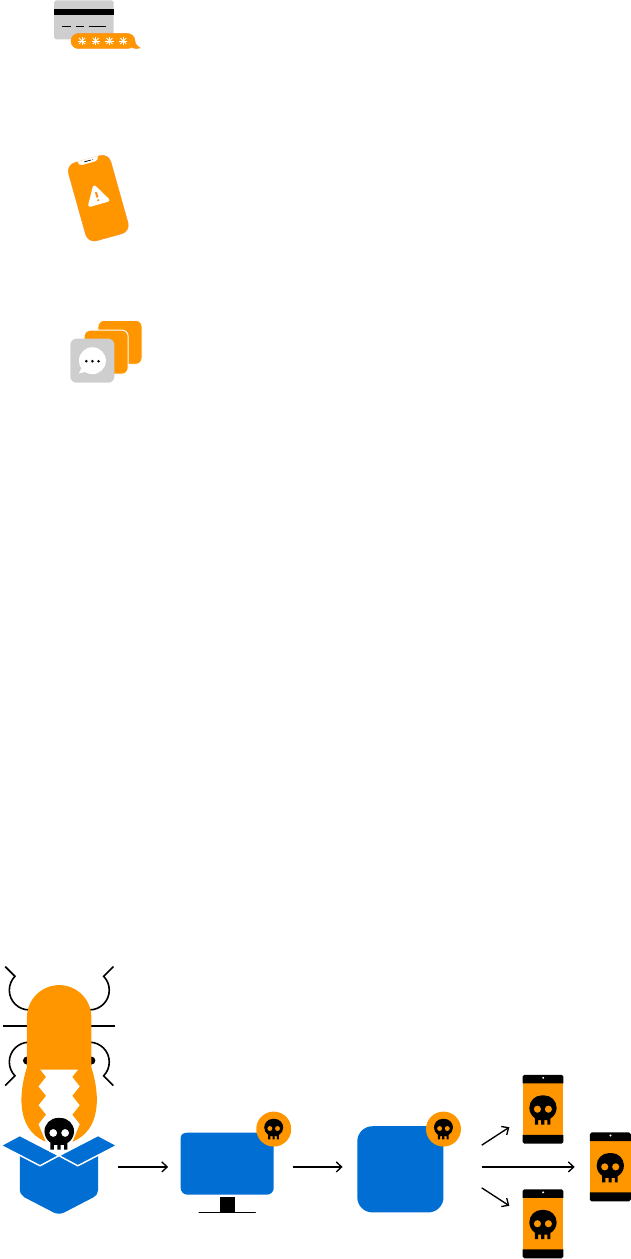
18
Website spoofing creates legitimate-looking websites that contain malware.
96
These websites frequently lead to malicious apps available for sideloading.
Examples include the aforementioned BlackRock Android trojan that spoofs the
website of the Clubhouse app, luring unsuspecting users into downloading the
trojan app instead of the legitimate app.
76
Scareware tricks users by claiming to detect threats to the device, often offering
solutions to those threats that involve sideloading an app containing malware.
97,98
For instance, Armor for Android falsely warns people that malware has been
detected on their devices, advising users to download its antivirus app, which
then scams them.
99
Potentially unwanted applications are software packaged along with genuine
apps that tailgate their way onto devices when users install the genuine apps.
They can contain malware and drain devices’ resources.
100
For example, over 100
Android apps, with more than 4.6 million combined downloads, contain the Soraka
potentially unwanted application adware.
101
Hackers can also use supply chain attacks to infect user devices. Instead of
tricking users into downloading infected apps, these attacks infiltrate and spread by
tricking developers of legitimate apps.
102
One way those attacks have proliferated
is through infected software development kits (SDKs), the building blocks used by
app developers to build apps.
103
Cybercriminals and hackers can deliver malware
to users by modifying and inserting malicious code in SDKs used by unsuspecting
developers.
104
These attacks take advantage of the trust that users have in apps
made by legitimate developers. For example, SWAnalytics, an Android data
analytics SDK, hides Operation Sheep, a contact-stealing malware package. As
of March 2019, 12 Android apps infected with this malware, with over 111 million
downloads, had circulated in major third-party app stores.
105
Hackers often reuse the same malware strain, which they repackage into
variants. Rather than creating entirely new malware – a costly endeavor – hackers
modify existing malware into new versions to either improve it or spread it in other
ways. Malware variants for Android have grown significantly in recent years.
106,107
App
</>
SDK
19
The risks of opening the ecosystem
Because cybercriminals and hackers rely heavily on apps to spread malware,
first-party app stores have invested in extensive processes to screen and
remove malicious apps.
108,109,110
As the threat of malware has increased, these
screening processes have become stricter and have dedicated a greater amount of
resources to reviewing apps.
111,112
And, if harmful apps are found on first-party app
stores, they can be removed from distribution, preventing further user exposure.
113,114
On the other hand, the large amount of malware on third-party app stores
shows they do not have sufficient vetting procedures to check for harmful apps
(and direct download websites have no independent vetting), so cybercriminals and
hackers have relied on third-party app stores or direct downloads to spread their
apps, taking advantage of the lack of oversight and the inability to control the spread
of malware: Over 99 percent of known mobile malware originates on third-party app
stores.
15,18
A study of malicious apps on Android found that once a malicious app is
detected and removed from one app store, it often simply migrates to other third-
party stores, and thus continues infecting consumer devices.
115,116
Because Android supports sideloading, malware has been able to spread on
that platform more easily. Android smartphones are the most common mobile
malware targets and have recently had between 15 and 47 times more infections
from malicious software than iPhone.
4,5
A study found that 98 percent of mobile
malware targets Android devices.
18
This is closely linked to sideloading: In 2018,
for example, Android devices that installed apps outside Google Play, the official
Android app store, were eight times more likely to be affected by potentially harmful
applications than those that did not.
103
For example, as previously discussed,
HiddenAds, CopyCat, FakeSpy, and BlackRock are all prominent malware strains that
reached Android users via third-party sources. In addition, because cybercriminals
and hackers rely on sideloading to spread pirated apps, piracy and intellectual
property theft are more common on Android devices.
24,25,117
On the other hand, iOS
users are unlikely to be exposed to malware, and many of the rare malware attacks on
the platform are narrowly targeted attacks, often carried out by nation-states.
82,83,118
Experts generally agree that iOS is safer compared to Android, in part because
Apple does not support sideloading.
5
If regulations force platforms to support sideloading without any user
protections, the harm to users could be even greater. The Android platform
currently retains some features that discourage sideloading by adding “friction”
for users – additional steps and warnings that prevent users from sideloading apps
without realizing it. For example, devices are set up not to sideload as a default
option, and corporate entities can disallow device-wide sideloading on employees’
devices.
119,120,121
Should regulations force platforms to support sideloading without
any friction, the threat of malware, piracy, and intellectual property theft on both
platforms would likely be higher as a result.

20
Apple tightly controls
the Developer
Enterprise Program
Only legal entities that have
validated their reasons for
using the program are eligible,
and they can only distribute
apps to their employees.
Apple can and does revoke the
developer certificates of busi-
nesses that misuse them.
Employees who download
apps created through the
program must go into their
device settings and affirm that
they trust the business – their
employer – which ensures users
truly intend to download an app
from outside of the App Store.
Most enterprise customers do
not use the program, as Apple
offers businesses alternative
ways to distribute apps to their
employees to limit participation
in the Developer Enterprise
Program. For instance, busi-
nesses can submit apps for
custom app distribution on the
App Store, a process by which
each app goes through the
App Review process before
becoming available within the
organization. Learn more here:
developer.apple.com/custom-
apps/.
The limited mechanism to distribute apps outside
of the App Store
Apple’s own experience with supporting the ability of a limited number of
enterprise developers to distribute apps outside of the App Store shows
that cybercriminals and even for-profit companies will go to great lengths
to bypass the App Store so they can spread malware and other illegitimate
apps. Apple created the Developer Enterprise Program to provide a way for large
organizations to develop and privately distribute apps (for instance, confidential
apps that cannot go through App Review), for use only by their organization’s
employees. Under the tightly controlled program, Apple issues certificates to
businesses, which allow them to distribute apps directly to their employees
under their IT departments’ supervision.
Despite the program’s tight controls and limited scale, bad actors have
found unauthorized ways of accessing it, for instance by purchasing
enterprise certificates on the black market. Bad actors have used illegitimately
obtained enterprise certificates to distribute apps that violate App Store policies,
including apps containing malware such as Goontact (see below) and pirated
versions of popular iOS apps.
122,123
Abuse of the Developer Enterprise Program
is not limited to cybercriminals. In 2019, for example, Apple revoked Facebook’s
enterprise certificate because it was used to distribute a VPN app called
Facebook Research that collected mobile data and usage habits – such as web
searches and browsing history, messages, and location data from Facebook
users – targeting some as young as 13.
124,125
Enterprise certificates are meant only
for internal use by a company, and are not intended for general app distribution,
as they can be used to circumvent App Store and iOS protections.
Apple has increased efforts to tighten controls on the program and add user
protections, but abuse has persisted. This demonstrates the enormous risk
posed by forcing Apple to support the ability of any developer to distribute
apps outside of the App Store to all iPhone users. If the option to distribute
apps via sideloading were available on a massive scale, without any restrictions,
and with Apple powerless to revoke certificates from bad actors in cases of
abuse, malware and other forms of illegitimate apps would run rampant.

21
Under the pretense of
improving video or audio
quality, operators prompt
targets to sideload a well-
known video-chatting app
(such as Telegram) from
a website that mimics the
design of a first-party
app store, guiding them
through the process
and coaxing them to
enable access privileges.
However, the sideloaded
app is fake and infected
with spyware.
HOW IT WORKS
After Android users
accept a prompt to grant
Goontact permissions, it
collects data on contacts,
SMS messages, location,
photos, and the device
identifier. On iOS devices,
the spyware can only
collect contacts and
device identifier data.
Goontact is multi-
platform spyware that
reaches users’ devices
through infected adult
video chat apps. The
spyware targets Android
users via sideloaded apps,
and is also able to target
iOS users by abusing the
Apple Developer Enter-
prise Program.
122
WHO IT AFFECTS
Goontact is currently
active across both Android
and iOS platforms, and
primarily targets users
in China, Japan, Korea,
Vietnam, and Thailand.
HOW IT REACHES
A USER’S DEVICE
Malicious actors lure
targets to websites
promising adult video
chats. However, they
are instead connected
with Goontact operators.
HOW IT TARGETS iOS USERS
Goontact abuses the privi-
leges of the Apple Developer
Enterprise Program by
obtaining unauthorized enter-
prise certificates. While Apple
revokes these certificates as
soon as they are discovered,
the malicious actors can
keep spreading their malware
through sideloading when
they procure additional illegit-
imate certificates.
ADDITIONAL LAYER OF ATTACK
During the first video chats
with a Goontact operator,
the cybercriminals record a
compromising video of the
target to use as blackmail.
After users download the
app, the spyware steals their
contacts and the cybercrim-
inals threaten to release the
video to their contact lists
unless a ransom is paid.
Goontact: Adult video
chat sites lure targets into
downloading spyware
Allow
“Telegram” to
access your
camera?
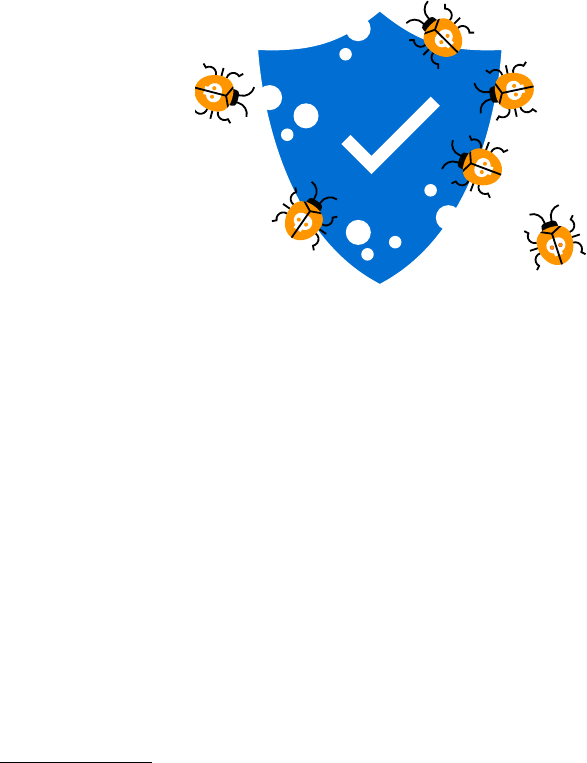
22
The impact of sideloading on the iOS ecosystem
Forcing sideloading onto the iOS ecosystem would make iPhone less
secure and trustworthy for users. This would be true regardless of whether
sideloading occurred via direct downloads or through third-party app stores.
Researchers agree that iPhone is the most secure consumer mobile device, and
it is rare for any user to encounter malware on iPhone.
5
Because iPhone provides
users with powerful and multi-layered security protections, it is usually not
possible for cybercriminals and hackers to attack iOS devices at scale. Through
the App Review process, Apple’s goal is to ensure that apps on the App Store
are trustworthy and safe. Apple is constantly improving this process, continually
updating and refining App Review’s tools and methodology.
Forcing Apple to support sideloading on iOS through direct downloads or third-
party app stores would weaken these layers of security and expose all users to
new and serious security risks: It would allow harmful and illegitimate apps to
reach users more easily; it would undermine the features that give users control
over legitimate apps they download; and it would undermine iPhone on-device
protections. Sideloading would be a step backwards for user security and privacy:
Supporting sideloading on iOS devices would essentially turn them into “pocket
PCs,” returning to the days of virus-riddled PCs.
First, if sideloading were supported, it would be easier for harmful apps
to reach users. Direct downloads are unvetted, and the large amount of
malware that proliferates on third-party app stores shows that those stores do
not have sufficient vetting procedures to check for harmful apps. Users would
now be responsible for determining whether sideloaded apps are safe, a very
difficult task even for experts. Apple currently protects users by vetting apps
and developers on the App Store, keeping illegitimate apps out, and quickly
containing the spread of harmful apps.
You can read Apple’s
recent paper, "Building
a Trusted Ecosystem
for Millions of Apps,"
to learn more about how
Apple’s device protection
and App Review keep
your device safe.

23
Malware: Sideloading would expose iOS users to apps that contain known strains
of malware. App Review screens all apps and app updates submitted to the App
Store to check for various types of known malware, including infected SDKs used
in supply chain attacks. By contrast, known malware such as HiddenAds remains
present on Android third-party app stores. (See above.)
Spoofing: If sideloading were supported on iOS, malicious actors would be able
to distribute copycat versions of popular apps that trick users. On the App Store,
apps come from known and vetted developers only, and their content is reviewed
by a member of the App Review team. This process works to prevent, for example,
a trojan app posing as a fake version of Clubhouse and stealing user login
credentials. (See above.)
Illegal, pirated, and stolen content: Sideloading would expose users to apps
with illegal content, such as illegal gambling apps, pirated apps, or apps containing
stolen intellectual property. They would be able to spread on the iOS platform
unchecked via third-party sources. Apple checks all apps submitted to the App
Store for illegal content prohibited by Apple’s policies.
Unsafe apps targeted at children: Supporting downloads outside of the App
Store would mean that parents may inadvertently sideload apps appearing to be
kid-friendly but which actually put their children at risk. App Store policies enforce
strict guidelines around data collection and security on apps in the Kids category.
For example, these apps may not include links outside of the app, send personally
identifiable information to third parties, or contain third-party analytics
or advertising.
Unchecked spread of harmful apps: In the rare cases in which a fraudulent or
malicious app makes it on the App Store, Apple can remove it immediately once
discovered, thereby stopping its spread to more users. Apple also identifies and
blocks variants of the original malware that cybercriminals try to repackage in other
apps, limiting its ability to mutate and spread further. For example, XcodeGhost
was a form of malware that spread through an infected version of Xcode (Apple’s
environment for writing and compiling apps) that unsuspecting developers
downloaded from a third-party website rather than from the Apple developers’
website.
126
Because the infected apps were centrally distributed through the App
Store, Apple was able to swiftly work with cybersecurity firms to identify and remove
them.
127
A mechanism such as sideloading, without centralized review, would
make it impossible to notify all impacted developers, and to control the spread of
harmful apps, because removing them from the App Store would not prevent them
from continuing to spread through third-party app stores and direct downloads.
Researchers have found that when harmful apps are removed from an app store on
the Android platform, malicious actors simply move them to alternative app stores.
115

24
Second, if sideloading were supported on iOS, users may not get accurate
information about apps they download via direct download or through third-
party app stores. Also, features that allow users to control what data apps are
able to access would either not work, or would be much easier for malicious
actors to manipulate. The App Store requires all developers to provide reliable
information about apps, and Apple has designed many features that give users the
ability to control what data apps are able to access.
Permissions: App Review checks that the app doesn’t request access to sensitive
permissions or data that are unnecessary for the app to function (for example, a
weather app requesting access to the microphone or to health data). App Review
also checks that apps do not make misleading or false claims when requesting
permissions from users. If sideloading were supported, however, sideloaded apps
would not have to be checked to see if they are improperly requesting and obtaining
sensitive permissions and data, such as access to the device microphone or location
data, regardless of whether this permission is needed for the app to function.
Sideloaded apps may also attempt to trick users into granting permissions using
manipulative or false messages.
Reliable information for users: On the App Store, app developers are required
to submit a description of their app and its features, screenshots of the app, and
privacy information explaining what kind of data the app links to users’ identities and
whether that data is used to track them across third-party websites and apps. This
ensures that users know what to expect when deciding whether to download an app
and that they are not misled by malicious actors impersonating trusted developers.
If sideloading were supported, users could not be sure that apps downloaded
outside the App Store are what they expected to download, and they may not have
information on the apps’ privacy practices.
Privacy protections: Privacy is at the core of Apple’s ecosystem. All apps on the
App Store need to get users’ permission before tracking them across third-party
apps or websites through the App Tracking Transparency feature. Sideloading would
render this protection ineffective: While users could prevent sideloaded apps from
accessing their Identifier for Advertisers (IDFA), sideloaded apps could access other
device or user data, and their developers would not be required to abide by choices
made by users to opt out of tracking. As a result, users’ data may be collected
and shared without their permission. In addition, developers may have different
incentives, and may choose not to protect users’ data the same way that Apple does.
Some developers allege that they have lost advertising revenue due to App Tracking
Transparency, and thus would have an incentive to sideload their apps specifically to
bypass these privacy protections.
128
Furthermore, some developers, including social
media platforms, have a history of abusing user privacy and safety, and have created
apps that violate App Store guidelines designed to protect iOS users.
124,129
Learn more about
Apple’s privacy
protections
To learn more about how
the App Tracking Trans-
parency and privacy labels
on the App Store give you
control and transparency
on how apps collect and
use your data, read "A Day
in the Life of Your Data"
and visit apple.com/
privacy/control.
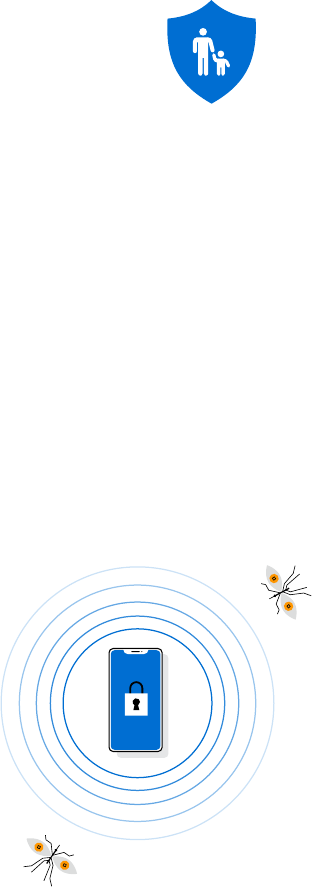
25
Parental controls: Apple has designed features that give parents control over
how kids use iOS devices. Screen Time gives parents an understanding of the
time kids spend using their devices, and allows parents to limit the amount of
time they can spend each day on certain apps and websites. The Ask to Buy
feature allows parents to approve or decline kids’ app downloads and purchases
made via in-app purchasing, and has a 15-minute timeout to prevent subsequent
purchases. Sideloading would weaken these parental control features, which
could be easily bypassed by apps downloaded outside of the App Store. For
instance, a game app could identify itself as an education app to evade Screen
Time limits on game usage. And non-App Store purchases on sideloaded apps
would not be controlled by Ask to Buy.
Report a Problem: Apple provides features that allow users to request refunds
for some purchases from the App Store, as well as to report app privacy violations
or safety issues. These features ensure that users have recourse if something
goes wrong, such as being a victim of fraud or scams. Under sideloading, there
would be no guarantee that third-party app stores would offer fair, clear, and
consistent refund policies, or provide customer support in cases where there is
a problem with an app.
Subscriptions: Apple’s subscription management tool allows users to view all
their paid subscriptions made through in-app purchases in a single place. Users
can see how much and how often they will be charged for in-app subscriptions,
and they can easily cancel them. With sideloading, many developers could
choose to make their apps incompatible with these features, and make it
confusing and time-consuming for users to cancel subscriptions.
Finally, sideloading would undermine iPhone’s core on-device platform
security protections. For security reasons, Apple restricts apps from accessing
sensitive hardware elements (e.g., NFC chip, secure enclave, memory space, ultra
wideband) and does not permit apps to use non-public operating system functions.
Special entitlements – the right or privilege to use a sensitive service or technology
– are granted selectively to apps that require access for a specific purpose. For
example, the HealthKit entitlement determines whether an app may request user
permission to access health and activity data.
If Apple were forced to provide full access to proprietary hardware elements
and non-public operating system functions, as some efforts to force sideloading
on iOS would require, it would undermine core platform security features, such
as the sandboxing of apps and the separation between apps and the operating
system. The attack surface on iPhone would significantly expand, and fundamental
security protections would be endangered. For example, under some proposals,
the operating system would no longer be able to prevent apps from stealing or
modifying data from another app, or accessing location data, the microphone,
or the camera without user permission.
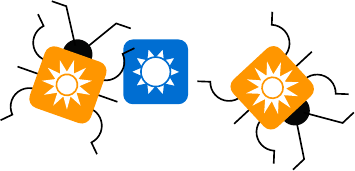
26
Sideloading would make it easier and cheaper to execute many attacks that are
currently difficult and costly to execute on iOS.
15
This would expand the universe
of attack techniques present on iOS, the set of users that are targeted, and the
number of cybercriminals. Supporting sideloading would lower the cost of carrying
out attacks on iPhone, incentivizing malicious actors to develop tools and expertise
to attack iPhone device security and privacy at an unprecedented scale.
Cybercriminals and hackers would take advantage of the adtech industrial
complex to reach their targets. They would use mobile ad networks to spread
harmful apps to users by targeting them with ads to install sideloaded apps. Mobile
ad networks earn billions of dollars a year from ads for mobile app installs, a practice
that would likely expand to include ads for malicious apps distributed through
sideloading.
130,131
Cybercriminals already use ads on social media platforms to target
users with malware for PC and many other types of scams.
132,133,134
Users would
face an onslaught of ads for malicious apps that these ad networks profit from and
therefore have little incentive to police.
135
Cybercriminals and hackers may also rely
on social media networks to spread malicious apps through social engineering,
exploiting people’s trust in their friends and family. As a result, users would bear the
burden of determining what is safe to click on and download.
Even users who decide they don’t want to sideload, and prefer to download apps
only from the App Store, would end up being harmed. They could be forced to
sideload an app they need for work, for school, or for social inclusion if it is not made
available on the App Store. Furthermore, cybercriminals and hackers may trick users
into unknowingly sideloading an app by mimicking the appearance of the App Store,
or by touting free or expanded access to services or exclusive features.
If Apple were forced to support sideloading via direct downloads and through
third-party app stores, iPhone users would have to constantly be on the lookout
for scams, never sure whom or what to trust, and, as a result, users would
download fewer apps from fewer developers. Developers themselves would
become more vulnerable to threats from malicious actors who offer developer tools
that contain and propagate malware. Developers would also be more vulnerable to
piracy and intellectual property theft, which would undermine their ability to get paid
for their efforts and innovation.
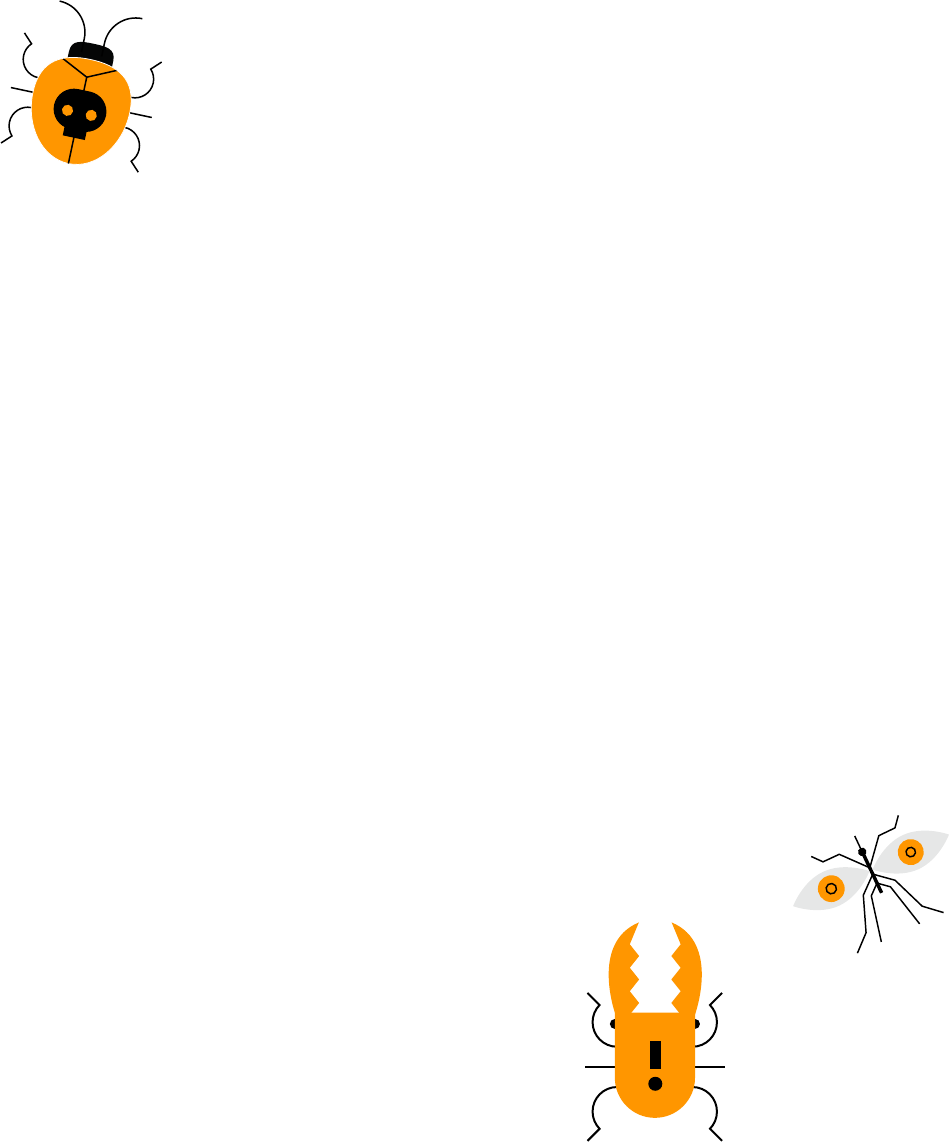
27
Sideloading and iOS users
Supporting sideloading on iOS devices would harm iOS users, whose security,
privacy, and personal data would be put at risk by the increased threat of
attacks by malicious actors. iOS users store personal, valuable, or sensitive
information on their mobile devices.
136
Many iOS users use mobile banking and
payment apps, and purchase goods and services on their devices.
137
Employees
also commonly connect to corporate networks on their mobile devices for work-
related tasks. App Store users come from all walks of life and all age groups, speak
different languages, and live all over the world. But one thing they have in common
is that they are all protected by the App Store safeguards.
Smartphone users have access to millions of apps, and download a large and
increasing number of apps. In many countries, users have over 90 apps installed
on their devices on average, and iOS users download almost 50 percent more apps
than they did five years ago.
138,139,140
Each sideloaded app could potentially pose a
threat to the security and privacy of users’ devices and their personal data.
As a result, Apple’s security and privacy features are critical to protecting the
hundreds of millions of iOS users. In fact, research shows that a majority of iOS
users report that they have only some or no knowledge of cybersecurity issues,
and do not change default security settings unless they run into specific issues.
136
Even among the small share of users with security expertise, when asked what
they prioritize when making security choices, roughly as many chose convenience
as chose security.
136
By reviewing every app before it becomes available on the App Store to ensure it is
free of malware and accurately represented to users, and by swiftly removing apps
from distribution if they are found to be harmful and limiting the spread of future
variants, Apple protects the security of the ecosystem and provides peace of mind
to customers. Sideloading is not in the best interest of users.

28
Guidance from security experts
Government and international agencies worldwide, as well as security
experts and cybersecurity providers, widely caution users about the risks
posed by downloading apps from third-party app stores:
“ One way to minimize danger
from third-party app stores
is to avoid them.”
Norton (cybersecurity provider)
148
“ The majority of [third-party] app
stores don’t enforce rigorous
security vetting of the apps they
offer, [and] this can make any
device on which they have been
installed particularly vulnerable
to threats.”
“ [Sideloading] should be forbidden
in [a company’s] BYOD policy.”
Wandera (mobile security company)
145,146
“ Only install apps from
official app stores.”
“ Companies should only
permit the installation of
apps from official sources
on those mobile devices
that connect to the
enterprise network.”
Europol
147
“ [Sideloading] if done incorrectly
could make a mobile device
extremely vulnerable to attack.”
National Institute of Standards
and Technology (United States
Department of Commerce)
144
“Third party apps pose a
security threat to users
who enable the installation
of apps from unverified
sources.”
Interpol and Kaspersky Lab
142
“ Users should avoid
(and enterprises should
prohibit on their devices)
sideloading of apps and
the use of unauthorized
app stores.”
Department of Homeland Security
(United States)
143
“ Users should only download
applications from Google
Play and not from third-party
sources, to minimise the
risk of installing a malicious
application.”
European Agency for Cybersecurity
141
29
1. Neville, Ann, “Recent cyber-attacks and
the EU’s cybersecurity strategy for the
digital decade,” European Parliamentary
Research Service, June 2021.
2. Chebyshev, Victor, “Mobile Malware
Evolution 2020,” Kaspersky, March 1, 2021.
3. Yablokov, Victor, “Why there’s no
antivirus for iOS,” Kaspersky, September
10, 2018.
4. Nokia, “Threat Intelligence Report
2020,” 2020.
5. Nokia, “Threat Intelligence Report
2019,” 2019.
6. RSA, “2018 Current State of
Cybercrime,” Dell Technologies, March
20, 2018.
7. Hautala, Laura, “Android malware tries
to trick you. Here’s how to spot it,” CNET,
May 14, 2021.
8. Mitre ATT&CK, “Techniques: Deliver
Malicious App via Other Means,” February
9, 2021.
9. Mitre ATT&CK, “Tactics: Initial Access,”
January 27, 2020.
10. Verizon, “2020 Data Breach
Investigations Report,” May 19, 2020.
11. Anderson, Sophie, “Antivirus and
Cybersecurity Statistics, Trends & Facts
2021,” Safety Detectives, January 24,
2020.
12. Verger, Rob, “Your anti-virus software
is not enough,” Popular Science, July 7,
2017.
13. Huang, Keman, et al., “Systematically
Understanding the Cyber Attack Business:
A Survey,” ACM Computing Surveys, Vol.
51, No. 4, July 2018, pp. 1-36.
14. Algarni, Abdullah and Malaiya,
Yashwant, “Software Vulnerability Markets:
Discoverers and Buyers,” World Academy
of Science, Engineering and Technology
International Journal of Computer and
Information Engineering, Vol. 8, No. 3,
2014, pp. 480-490.
15. RiskIQ, “2020 Mobile App Threat
Landscape Report,” 2020.
16. Burkhalter, Max, “Why BYOD culture
poses a major risk to enterprises,” Perle,
April 6, 2020.
17. Bitglass, “Mission Impossible: Securing
BYOD,” November 2018.
Sources
18. PurpleSec, “2021 Cyber Security
Statistics: The Ultimate List Of Stats, Data
& Trends,” 2021.
19. Ponemon Institute, “The Economic Risk
of Confidential Data on Mobile Devices in
the Workplace,” February 2016.
20. Holland, Jake, “T-Mobile Hit With Class
Action Suits After Consumer Data Breach,”
Bloomberg Law, August 20, 2021.
21. Check Point, “Mobile Security Report
2021,” April 2021.
22. IBM, “Cost of a Data Breach Report
2021,” July 2021.
23. Sophos, “The State of Ransomware
2020,” May 2020.
24. Brown, Mike, “Android’s Piracy
Problem Is Forcing Developers To Give
Away Games: ‘Alto’s Adventure’ Latest
Freebie,” International Business Times,
February 11, 2016.
25. Koetsier, John, “The Mobile Economy
Has A $17.5B Leak: App Piracy,” Forbes,
February 2, 2018.
26. Vincent, James, “TikTok clone Zynn
has now been removed from the iOS App
Store as well,” The Verge, June 16, 2020.
27. LeFebvre, Rob, “Apple pulls cloned
games from App Store,” VentureBeat,
February 7, 2012.
28. Dong, Feng, et al., “FrauDroid: An
Accurate and Scalable Approach to
Automated Mobile Ad Fraud Detection,”
September 6, 2017.
29. La Porta, Liarna, “Trojan malware
infecting 17 apps on the App Store,”
Wandera, October 24, 2019.
30. Trend Micro, “Mobile Ad Fraud
Schemes: How They Work, and How to
Defend Against Them,” April 26, 2019.
31. Takahashi, Dean, “Adjust says mobile
ad fraud rates doubled in the past year,”
VentureBeat, May 10, 2018.
32. Health Information National Trends
Survey, “On your tablet or smartphone,
do you have any software applications or
apps related to health?,” National Cancer
Institute, 2020.
33. Firch, Jason, “10 Cyber Security
Trends You Can’t Ignore In 2021,”
PurpleSec, April 29, 2021.
34. He, Terry, et al., “2021 Cyber Threat
Report,” SonicWall, 2021.
35. Cohen, Jessica Kim, “Hackers
taking advantage of COVID-19 to spread
malware,” Modern Healthcare, March 16,
2020.
36. Wang, Liu, et al., “Beyond the Virus: A
First Look at Coronavirus-themed Android
Malware,” Empirical Software Engineering,
Vol. 26, No. 82, June 12, 2021.
37. Chen, ZePeng, “Thousands of
HiddenAds Trojan Apps Masquerade as
Google Play Apps,” McAfee, March 3,
2020.
38. Avast, “Avast Reports Continued
Dominance of Adware Among Android
Threats,” June 16, 2021.
39. Kaspersky, “What is Adware? –
Definition and Explanation.”
40. Malwarebytes, “Android/Trojan.
FakeAdsBlock.”
41. Dr. Web Anti-Virus, “Clicker Trojan
Installed from Google Play by Some
102,000,000 Android Users,” August 8,
2019.
42. Osborne, Charlie, “CopyCat Android
malware infected 14 million devices, rooted
8 million last year,” ZDNet, July 7, 2017.
43. Check Point, “How the CopyCat
malware infected Android devices around
the world,” July 6, 2017.
44. Schwartz, Jaime-Heather, “How
to protect your Android phone from
ransomware – plus a guide to removing it,”
Avira, August 13, 2020.
45. Grustniy, Leonid, “Mobile beasts and
where to find them – part two,” Kaspersky,
August 3, 2018.
46. Holland, Tilly, “Ransomware Attacks:
What You Need To Know,” Ontrack, March
7, 2019.
47. PurpleSec, “2021 Ransomware
Statistics, Data, & Trends,” 2021.
48. Nicholas, Sarah, “You Can Beat the
Latest Security Breaches,” Ameris Bank,
July 19, 2021.
49. Cyber Florida, “Research Shows a
715% Increase in Ransomware Attacks
in 2020,” University of South Florida,
September 23, 2020.
50. Ostroff, Caitlin and Vigna, Paul, “Why
Hackers Use Bitcoin and Why It Is So
Difficult to Trace,” Wall Street Journal, July
16, 2020.
30
51. Stefanko, Lukas, “New ransomware
posing as COVID-19 tracing app targets
Canada; ESET offers decryptor,”
WeLiveSecurity by ESET, June 24, 2020.
52. Seals, Tara, “Emerging Ransomware
Targets Photos, Videos on Android
Devices,” Threatpost, June 24, 2020.
53. Emm, David, et al., “IT Threat Evolution
in Q2 2016,” Kaspersky, 2016.
54. Kaspersky, “KSN Report: Ransomware
in 2016-2017,” Kaspersky, 2017.
55. Venkatesan, Dinesh, “Sophisticated
new Android malware marks the latest
evolution of mobile ransomware,”
Microsoft, October 8, 2020.
56. Whitwam, Ryan, “Microsoft Spots
Android Ransomware That Hijacks Your
Home Button,” ExtremeTech, October 9,
2020.
57. Osborne, Charlie, “How to find and
remove spyware from your phone,” ZDNet,
August 9, 2021.
58. Kaspersky, “Avoiding Cell Phone
Spyware Infestation.”
59. Shatilin, Ilja, “Mobile beasts and
where to find them – part four,” Kaspersky,
October 22, 2018.
60. Palmer, Danny, “AndroRAT: New
Android malware strain can hijack older
phones,” ZDNet, February 14, 2018.
61. Federal Trade Commission, “FTC
Brings First Case Against Developers of
“Stalking” Apps,” October 22, 2019.
62. Federal Trade Commission, “FTC
Bans SpyFone and CEO from Surveillance
Business and Orders Company to Delete
All Secretly Stolen Data,” September 1,
2021.
63. Vaas, Lisa, “SpyFone & CEO Banned
From Stalkerware Biz,” Threatpost,
September 2, 2021.
64. Citron, Danielle Keats, “Spying Inc.,”
Washington and Lee Law Review, Vol. 72,
No. 3, June 1, 2015, pp. 1234-1282.
65. Securelist, “The State of Stalkerware in
2020,” Kaspersky, February 26, 2021.
66. Cybereason Nocturnus Team,
“FakeSpy Masquerades as Postal Service
Apps Around the World,” Cybereason, July
1, 2020.
67. Almkias, Ofir, “FakeSpy,” Mitre
ATT&CK, October 6, 2020.
68. National Cyber Security Centre, “Fake
‘missed parcel’ messages: advice on
avoiding banking malware,” August 19,
2021.
69. Finnish Transport and Communications
Agency, “Android malware spread by
SMS,” July 15, 2021.
70. Desai, Shivang, “SpyNote RAT posing
as Netflix app,” Zscaler, January 23, 2017.
71. Black, Daniel, “HelloSpy App Review
2021: Will the App Resume Its Work?,”
mSpy, March 5, 2021.
72. Cox, Joseph, “I Tracked Myself With
$170 Smartphone Spyware that Anyone
Can Buy,” Vice, February 22, 2017.
73. Kochetkova, Kate, “Mobile banking
Trojans, explained,” Kaspersky, October
14, 2016.
74. Stefanko, Lukas, “Android Banking
Malware: Sophisticated Trojans vs. Fake
Banking Apps,” ESET, January 2019.
75. Owaida, Amer, “Beware Android trojan
posing as Clubhouse app,” WeLiveSecurity
by ESET, March 18, 2021.
76. ThreatFabric, “BlackRock – the Trojan
that wanted to get them all,” ThreatFabric,
July 2020.
77. O’Donnell, Lindsey, “Banking.BR
Android Trojan Emerges in Credential-
Stealing Attacks,” Threatpost, April 21,
2020.
78. Asoltanei, Oana, et al., “Threat Actors
Use Mockups of Popular Apps to Spread
Teabot and Flubot Malware on Android,”
Bitdefender Labs, June 1, 2021.
79. Cleafy, “TeaBot: a new Android
malware emerged in Italy, targets banks in
Europe,” May 31, 2021.
80. Cyware, “Exploring the Nature and
Capabilities of Anubis Android Banking
Trojan,” January 25, 2020.
81. Clark, Mitchell, “NSO’s Pegasus
spyware: here’s what we know,” The
Verge, July 23, 2021.
82. Whittaker, Zack, “A new NSO zero-
click attack evades Apple’s iPhone
security protections, says Citizen Lab,”
TechCrunch, August 24, 2021.
83. NPR, “Malware From An Infamous
Hacker-For-Hire Group Was Found On
Nearly 900 Phones,” July 19, 2021.
84. Infrascale, “Enterprise Ransomware
Survival Guide,” May 25, 2016.
85. Yaswant, Aazim, “FlyTrap Android
Malware Compromises Thousands of
Facebook Accounts,” Zimperium, August
9, 2021.
86. Hazum, Aviran, et al., “New Wormable
Android Malware Spreads by Creating
Auto-Replies to Messages in WhatsApp,”
Check Point Research, April 7, 2021.
87. Jama, Robleh, “The upside of copycat
apps and how to deal with them if they get
out of hand,” TheNextWeb, April 9, 2016.
88. Hinchliffe, Alex and Palo Alto
Networks, “Techniques: Masquerade as
Legitimate Application,” Mitre ATT&CK,
April 8, 2020.
89. Peterson, Andrea, “Beware: New
Android malware is ‘nearly impossible’ to
remove,” The Washington Post, November
6, 2015.
90. Trend Micro, “Malware in Apps’
Clothing: A Look at Repackaged Apps,”
May 15, 2014.
91. Toulas, Bill, “Researchers Found 164
‘Copycat’ Apps That Tricked 10 Million
Users,” TechNadu, January 14, 2021.
92. Yaswant, Aazim, “New Advanced
Android Malware Posing as ‘System
Update’,” Zimperium, March 26, 2021.
93. European Union Agency for
Cybersecurity, “Phishing on the rise,”
October 12, 2017.
94. Eremin, Alexander, “People infected
with coronavirus are all around you, says
Ginp Trojan,” Kaspersky, March 24, 2020.
95. Pak, ChanUng, “Phishing Android
Malware Targets Taxpayers in India,”
McAfee, September 3, 2021.
96. Malwarebytes, “What is a spoofing
attack?”
97. Fitriah, Andi, et al., “Understanding
Android Financial Malware Attacks:
Taxonomy, Characterization, and
Challenges,” Journal of Cyber Security
and Mobility, Vol. 7, No. 3, June 14, 2018,
pp. 1-52.
98. Kaspersky, “What is Scareware?,”
Kaspersky.
99. Sims, Gary, “Exposé: Don’t fall victim
to this dodgy anti-virus app,” Android
Authority, February 5, 2014.
100. Malwarebytes, “Mobile PUP,” June
9, 2016.
31
101. Satori Threat Intelligence and
Research Team, “Bringing Starchild Down
to Earth: Soraka SDK,” Human Security,
December 2019.
102. Korolov, Maria, “Supply chain attacks
show why you should be wary of third-
party providers,” CSO from International
Data Group, February 4, 2021.
103. Android, “Android Security & Privacy
2018 Year In Review,” March 2019.
104. Clayton, Richard, “Mobile Supply
Chain Attacks Are More Than Just an
Annoyance,” Check Point, 2019.
105. He, Feixiang and Polkovnichenko,
Andrey, “Operation Sheep: Pilfer-Analytics
SDK in Action,” Check Point, March 13, 2019.
106. Trend Micro, “Variant.”
107. Sen, Sevil, et al., “Coevolution of
Mobile Malware and Anti-Malware,” IEEE
Transactions on Information Forensics and
Security, Vol. 13, No. 10, October 2018, pp.
2563-2574.
108. Australian Competition &
Consumer Commission, “Digital Platform
Services Inquiry: Interim Report – App
Marketplaces,” March 2021.
109. Apple Developer, “App Store Review
Guidelines.”
110. Google Play Help, “Google Play
Protect keeps your apps safe and your data
private.”
111. O’Donnell, Lindsey, “Google Play
Cracks Down on Malicious Apps,”
Threatpost, February 14, 2019.
112. Mohan, Babu, “Google now takes
three days to approve new Play Store
apps,” Android Central, August 20, 2019.
113. Apple, “App Store stopped more
than $1.5 billion in potentially fraudulent
transactions in 2020,” May 11, 2021.
114. Guertin, Alec and Kotov, Vadim, “PHA
Family Highlights: Bread (and Friends),”
Google Security Blog, January 9, 2020.
115. Shen, Yun, et al., “A Large-scale
Temporal Measurement of Android
Malicious Apps: Persistence, Migration,
and Lessons Learned,” Cornell University:
Computer Science – Cryptography and
Security, August 10, 2021.
116. Lindorfer, Martina, et al., “AndRadar:
Fast Discovery of Android Applications
in Alternative Markets,” 11th Conference
on Detection of Intrusions and Malware &
Vulnerability Assessment, July 2014.
117. Smith, Chris, “Another crucial reason
why app developers prefer iOS to Android,”
BGR, February 4, 2016.
118. Kujawa, Adam, et al., “2020 State of
Malware Report,” Malwarebytes, February
2020.
119. N-Marandi, Sara, “What’s new in
Android privacy,” Android Developers
Blog, May 18, 2021.
120. Johnson, Kyle, “How do you block
sideloaded app installation on iOS or
Android?,” TechTarget, January 9, 2019.
121. Tee, Mike, “How to Install Apps
from Unknown Sources in Android,”
MakeTechEasier, February 16, 2020.
122. Nickle, Robert, et al., “Lookout
Discovers New Spyware Used by
Sextortionists to Blackmail iOS and Android
Users,” Lookout, December 16, 2020.
123. Nellis, Stephen and Dave, Paresh,
“Software pirates use Apple tech to
put hacked apps on iPhones,” Reuters,
February 13, 2019.
124. Owen, Malcolm, “Apple has revoked
Facebook’s enterprise developer
certificates after sideload violations,”
AppleInsider, January 30, 2019.
125. Axon, Samuel, “Apple revokes
Facebook’s developer certificate over
data-snooping app—Google could be
next,” Ars Technica, January 30, 2019.
126. Xiao, Claud, “Novel Malware
XcodeGhost Modifies Xcode, Infects Apple
iOS Apps and Hits App Store,” Palo Alto
Networks, September 17, 2015.
127. Xiao, Claud, “More Details on the
XcodeGhost Malware and Affected iOS
Apps,” Palo Alto Networks, September 21,
2015.
128. Fischer, Sara, “Facebook says Apple’s
ad changes are hurting its business,”
Axios, September 22, 2021.
129. Seetharaman, Deepa, “Facebook
Removes Data-Security App From Apple
Store,” Wall Street Journal, August 22,
2018.
130. Rosenfelder, Shani, “Global app install
ad spend to double by 2022 to hit $118
billion,” AppsFlyer, February 13, 2020.
131. Brown, Eileen, “Facebook leads app
install market share, but Google is rising
fast,” ZDNet, October 19, 2018.
132. Whittaker, Zack, “Facebook ran ads
for a fake ‘Clubhouse for PC’ app planted
with malware,” TechCrunch, April 8, 2021.
133. Newman, Lily Hay, “Facebook Shut
Down Malware That Hijacked Accounts to
Run Ads,” Wired, October 1, 2020.
134. McGuire, Michael, “The Web of Profit:
Social Media Platforms and the Cybercrime
Economy,” Bromium, 2019.
135. Rastogi, Vaibhav, et al.,
“Understanding In-App Ads and Detecting
Hidden Attacks through the Mobile
App-Web Interface,” IEEE Transactions
on Mobile Computing, Vol. 17, No. 11,
November 1, 2018, pp. 2675-2688.
136. Breitinger, Frank, et al., “A survey
on smartphone users’ security choices,
awareness and education,” Elsevier:
Computers & Security, Vol. 88, October
11, 2019.
137. Centre for International Governance
Innovation – Ipsos, “Global Survey on
Internet Security & Trust,” 2017.
138. App Annie, "The State of Mobile,"
2019.
139. Nelson, Randy, “Store Intelligence:
Q1 2016 Data Digest,” Sensor Tower, April
18, 2016.
140. Sensor Tower, “Q4 2020 Store
Intelligence Data Digest,” 2020.
141. European Union Agency For
Cybersecurity, “Vulnerabilities –
Separating Reality from Hype,” August 24,
2016.
142. Kaspersky and Interpol, “Mobile
Cyber Threats,” October 2014.
143. U.S. Department of Homeland
Security, “Study on Mobile Device
Security,” April 2017.
144. Franklin, Joshua M, et al.,
“Guidelines for Managing the Security of
Mobile Devices in the Enterprise,” U.S.
Department of Commerce – National
Institute of Standards and Technology,
March 2020.
145. Urwin, Matt, “Top 5 Types of
Sideloaded Apps and the Risks They Pose,”
Wandera, December 19, 2018.
146. Velzian, Becci, “How to Create a Bring
Your Own Device (BYOD) Policy,” Wandera,
January 13, 2021.
147. Europol, “Just a Game? Only install
apps from official app stores,” European
Cybercrime Centre.
148. Gervais, Joe, “The risks of third-party
app stores,” Norton, July 18, 2018.
